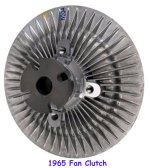**warning long post below**
Chris Sale is a mind of useful information on especially C2's but as he's in the wilds of Canada presently he asked that I post this article he wrote that may help the OP and others.
C2 Corvette Temperature Gauge Calibration
Have you ever wondered how accurate your temperature gauge really is?
I had never thought much about this until I changed the intake manifold on my ’64 a few years ago. I use a 170 degree thermostat, and at the point where my thermostat opened and I could feel a good flow of hot water through my top hose, my temperature gauge needle was always a little to the left of the 180 mark and this was good enough for me.
I had done some homework prior to changing my manifold and I knew that the temperature sender was a key component in obtaining accurate readings. The sender is a variable resistor whose resistance changes with temperature, but the profile of resistance versus temperature is not a straight line. The gauge itself is designed to compensate for this non-linear response.
I had tried to remove my original sender but after 40+ years installed in a cast iron manifold it didn’t want to move, so I thought that maybe it was best to leave it alone. On various bulletin boards I had seen that the Wells TU-5 sender was considered closest to the original AC sender, so this is what I installed in my new manifold. However, when I first ran my engine with the new manifold and sender, I found that at the thermostat opening point the gauge needle was now well to the right of the 180 mark, almost up to the mark between 180 and 240 on the gauge. In other words, the gauge was now reading somewhere around 30 degrees high.
After getting the high reading I removed the TU-5 it and replaced it with another used AC sender. The needle was now not quite so far to the right of the 180, but was still too high. This caused considerable annoyance, plus a determination to sort the problem.
It was at this point that I decided the time had come to contact fellow NCRS member Jack Humphrey in the US. Jack is an Electrical Engineer who has helped me with various issues over the years. He pointed me to two articles he had written about temperature gauges and senders a few years ago and these were veritable mines of information. My attention was immediately drawn to the copy of the temperature versus resistance curves for the original C2 AC 1513321 temperature sender. Although a little difficult to read in places, it is immediately apparent that we are not exactly dealing with a precision instrument, particularly at the lower temperatures:
Note that with a temperature sender resistance of 240 ohms, the temperature could be anywhere between 115 and 130 deg F. Even with a sender resistance of 80 ohms, the temperature could range from 200 to 210 deg F.
These variations are acceptable, but the picture can change dramatically if you no longer have your original sender. In my case, even with a supposedly accurate Wells TU-5, my gauge was reading somewhere around 210F when the actual coolant temperature was around 175F. The problem is that although different senders look alike, simply measuring their resistance at room temperature is no guarantee of how they will perform on your engine, because the resistance range at lower temperatures is so broad and in any case the chart does not show the resistance range below 100F.
The other point to be aware of is that at the factory, temperature gauges were calibrated by hooking them up to a precision voltage/current source corresponding to what the gauge would see from the standard temperature sender on an engine running at the high end of the temperature scale. With early gauges the assembler then installed the needle to point to the correct temperature. With later gauges (starting sometime in 1965) a hand-selected shunt resistor was used to force the correct reading. In other words, the temperature gauge was matched to the characteristics of the temperature senders being installed when the car was first produced. Accuracy was thus also a function of how the gauge assembler was feeling on the day.
The significance of this is that unless your gauge is original and has never been sent away for restoration, and unless you still have your correct original temperature sender, the chances are that your temperature gauge is giving you readings that are not even close to the actual coolant temperature. If, therefore, this article has made you suspicious of what your temperature gauge is telling you, I suggest the following courses of action:
Use Substitute Resistors
A good starting point is to make up some test leads with known resistors and see what readings your gauge gives you when these resistors are used in place of whatever sender you have. These checks must be made with your engine running and with charging stabilised, so that the temperature gauge is seeing the same voltage that it would see on the road.
I made up four test leads using 50, 100, 150 and 200 ohm 1W fixed resistors. Connect these in turn between the temp sender lead and ground, and see what temperature your gauge is indicating. If your gauge is functioning correctly, the temperature readings that you get with each of these resistors should be reasonably close to what you see on the original temperature versus resistance curves.
Check the Thermostat Opening Temperature
If you know what the real opening temperature of your thermostat is, see how close to this temperature your temperature gauge is reading at the point when the thermostat opens. This should normally be when you can start to feel a good flow of hot water from the thermostat housing into the top hose.
Use an IR Thermometer
Obtain an accurate IR Thermometer and take readings from the lower surface of the top hose close to the thermostat housing, once the thermostat is open and you have a good flow through the top hose. If you take this approach and if you have not used an IR thermometer before, I recommend that you first experiment by taking readings while heating water in containers that have different external surfaces. You may find, as I did, that you will get misleading readings from polished surfaces.
After performing these checks, you should have a good idea how much correction to make to the readings you are seeing on your temperature gauge. However, don’t forget that even when new, the readings were only +/- 10F degrees accurate at best.
How did I restore accuracy to my gauge? I spent many frustrating hours trying to calibrate aftermarket temperature senders using pans of hot water on the stove, but I found it impossible to obtain consistent readings. I then went back to my original intake manifold and managed to remove my original temperature sender after several days’ soaking with WD-40. I installed this in my new manifold and my temperature gauge now reads exactly as it did before.
Finally, a word of warning……
Replacement temperature senders cause gauges to read high because their temperature versus resistance curves are lower than the curves for original senders. A method that is sometimes used to make a high-reading temperature gauge show the correct temperature under normal operation is to install a variable resistor between the sender and the gauge, and then ‘dial in’ sufficient extra resistance to bring the gauge needle back down to the correct temperature.
The problem with doing this is that the gauge is now only giving a correct reading at that particular temperature. By adding resistance, you have artificially increased the minimum resistance that the gauge will now see from the sender. This means that you have now set a limit on how high the gauge will read, and this in turn means that the gauge will no longer be able to indicate a genuine over-heating condition.
Chris Sale
CCCUK 436

